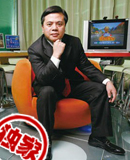工商管理硕士研究生入学考试英语模拟试题之二(4)
28. The text suggests which of the following about air pollution? [A] Further attempts to reduce emissions from gasoline-fueled vehicles will not help lower urban air-pollution levels. [B] Attempts to reduce the pollutants that an individual gasoline-fueled vehicle emits have been largely unsuccessful. [C] Few serious attempts have been made to reduce the amount of pollutants emitted by gasoline-fueled vehicles. [D] Pollutants emitted by gasoline-fueled vehicles are not the most critical source of urban air pollution。
29. Which of the following most closely parallels the situation described in the first sentence of the text? [A] Although a town reduces its public services in order to avoid a tax increase, the town’s tax rate exceeds that of other towns in the surrounding area. [B] Although a state passes strict laws to limit the type of toxic material that can be disposed of in public landfills, illegal dumping continues to increase. [C] Although a town’s citizens reduce their individual use of water, the town’s water supplies continue to dwindle because of a steady increase in the total populating of the town. [D] Although a country attempts to increase the sale of domestic goods by adding a tax to the price of imported goods, the sale of imported goods within the country continues to increase。
30. It can be inferred that the author of the text most likely regards the criticism of methanol as [A] flawed because of the assumptions on which it is based. [B] inapplicable because of an inconsistency in the critics’ arguments. [C] misguided because of its exclusively technological focus. [D] inaccurate because it ignores consumers’ concerns。
Text 3
The use of heat pumps has been held back largely by skepticism about advertisers’ claims that heat pumps can provide as many as two units of thermal energy for each unit of electrical energy used, thus apparently contradicting the principle of energy conservation。
Heat pumps circulate a fluid refrigerant that cycles alternatively from its liquid phase to its vapor phase in a closed loop. The refrigerant, starting as a low-temperature, low-pressure vapor, enters a compressor driven by an electric motor. The refrigerant leaves the compressor as a hot, dense vapor and flows through a heat exchanger called the condenser, which transfers heat from the refrigerant to a body of air. Now the refrigerant, as a high-pressure, cooled liquid, confronts a flow restriction which causes the pressure to drop. As the pressure falls, the refrigerant expands and partially vaporizes, becoming chilled. It then passes through a second heat exchanger, the evaporator, which transfers heat from the air to the refrigerant, reducing the temperature of this second body of air. Of the two heat exchangers, one is located inside, and the other one outside the house, so each is in contact with a different body of air: room air and outside air, respectively。
The flow direction of refrigerant through a heat pump is controlled by valves. When the refrigerant flow is reversed, the heat exchangers switch function. This flow-reversal capability allows heat pumps either to heat or cool room air。
Now, if under certain conditions a heat pump puts out more thermal energy than it consumes in electrical energy, has the law of energy conservation been challenged? No, not even remotely: the additional input of thermal energy into the circulating refrigerant via the evaporator accounts for the difference in the energy equation。
Unfortunately there is one real problem. The heating capacity of a heat pump decreases as the outdoor temperature falls. The drop in capacity is caused by the lessening amount of refrigerant mass moved through the compressor at one time. The heating capacity is proportional to this mass flow rate: the less the mass of refrigerant being compressed, the less the thermal load it can transfer through the heat-pump cycle. The volume flow rate of refrigerant vapor through the single-speed rotary compressor used in heat pumps is approximately constant. But cold refrigerant vapor entering a compressor is at lower pressure than warmer vapor. Therefore, the mass of cold refrigerant — and thus the thermal energy it carries — is less than if the refrigerant vapor were warmer before compression。
Here, then, lies a genuine drawback of heat pumps: in extremely cold climates — where the most heat is needed — heat pumps are least able to supply enough heat.31. The primary purpose of the text is to [A] explain the differences in the working of a heat pump when the outdoor temperature changes. [B] contrast the heating and the cooling modes of heat pumps. [C] describe heat pumps, their use, and factors affecting their use. [D] advocate the more widespread use of heat pumps.32. The author resolves the question of whether heat pumps run counter to the principle of energy conservation by [A] carefully qualifying the meaning of that principle. [B] pointing out a factual effort in the statement that gives rise to this question. [C] supplying additional relevant facts. [D] denying the relevance of that principle to heat pumps.33. It can be inferred from the text that, in the course of a heating season, the heating capacity of a heat pump is greatest when [A] heating is least essential. [B] electricity rates are lowest. [C] its compressor runs the fastest. [D] outdoor temperatures hold steady.34. If the author’s assessment of the use of heat pumps (lines 1-4) is correct, which of the following best expresses the lesson that advertisers should learn from this case? [A] Do not make exaggerated claims about the products you are trying to promote. [B] Focus your advertising campaign on vague analogies and veiled implications instead of on facts. [C] Do not use facts in your advertising that will strain the prospective client’s ability to believe. [D] Do not assume in your advertising that the prospective clients know even the most elementary scientific principles.35. The text suggests that heat pumps would be used more widely if [A] they could also be used as air conditioners. [B] they could be moved around to supply heat where it is most needed. [C] their heat output could be thermostatically controlled. [D] people appreciated the role of the evaporator in the energy equation。
特别说明:由于各方面情况的不断调整与变化,新浪网所提供的所有考试信息仅供参考,敬请考生以权威部门公布的正式信息为准。
网友评论
更多关于 考研 MBA 的新闻
- 专家指导:MBA学子毕业后的三大种职业选择2009-11-11 17:54:04
- 备考指导:MBA全国联考英语面试经典35题2009-11-11 17:46:10
- 备考资料:MBA联考管理模拟习题2009-11-09 23:52:53
- 备考资料:MBA数学重点模拟习题2009-11-09 23:45:13
- 2010年MBA备考资料:英语模拟题2009-11-09 23:38:44
- 2010年MBA备考资料:逻辑模拟试题2009-11-09 23:35:11
- MBA模拟试题:逻辑模拟测试题一2009-11-09 23:31:52






